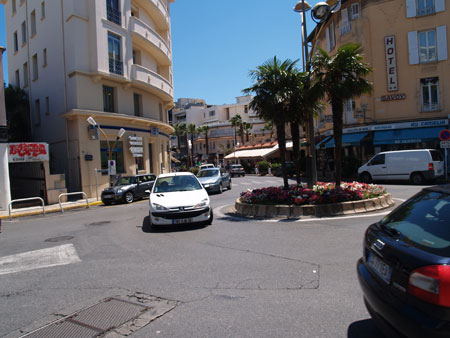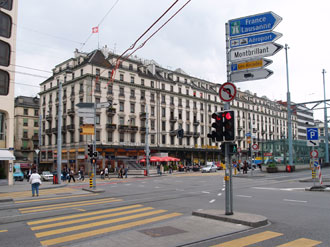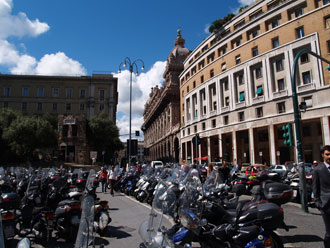There are some compelling reasons for not driving in Europe.
The trains are clean, comfortable and efficient. The historic quarters of most European cities are within walking distance of train stations. Pricey gas, extortionate tolls and stiff parking rates make driving much more costly than in the U.S. Those accustomed to gracious U.S. roads find most European streets cramped, confusing and nerve-wracking.
But if you abhor the thought of being trapped on a rail car or tour bus for long hours, a car is the only way to see Europe. The lure of the open road is no less powerful in Europe than in the States. In some ways, it’s even more irresistible. Once you’ve driven through a few dozen American states, the next bend is less likely to yield a breathtaking scene than on a continent chock full of unfamiliar sights.
Here’s an account of our 14-Day Road Trip through Southwestern Europe

Rotaries like this one in the upscale seaside resort of Antibes, near Cannes, on the French Riviera, dispense with the need for drivers to come to stops at 3-, 4- and 5-way intersection
Starting Point
The first decision is the starting point for your loop. London, Paris, Nice, Amsterdam, Frankfurt, Madrid and Barcelona are some obvious choices. We chose Barcelona because it seemed the ideal entry point for a loop enclosing Europe’s seductive southwest. The city is served by frequent flights from a dozen North American cities. Being near the western end of the Continent, there is minimal overlap between air miles and road miles. Barcelona International Airport is ultra-modern, efficient and located barely 15 minutes southwest of the city’s throbbing heart. For a seaside city, Barcelona streets are surprisingly orthogonal and spacious, allowing a relatively painless transition from driving an SUV through suburban avenues to maneuvering a compact stick shift through tight European streets.
Renting a Car
The next decision is the car. Barcelona International Airport offers rentals by familiar U.S. names like Hertz, Avis and Dollar. It also houses three European rental firms most Americans wouldn’t recognize. We chose Hertz and made an online reservation for a subcompact Toyota hatchback that we figured would be just big enough to carry the three of us and a couple of suitcases. One reason: European gas goes for the equivalent of about $6.50 a gallon (at $1.22 for a Euro). The more important reason was our memory of Europe’s tight alleys and parking spaces. And we opted for a stick shift. Not only did it cut the rental fee by about 15% but it saved about 10% on our fuel consumption.

This intersection on the Rambla del Poble Nou, one of Barcelona’s most pleasant streets, illustrates one big source of initial confusion for visiting drivers: broad pedestrian areas featuring outdoor dining tables run along the center of many major avenues, requiring cars to cross three separate flows of cross-traffic — two narrow auto routes and a wide pedestrian thoroughfare at the center.
Using GPS
After making the initial reservation, we opted to add a GPS unit (which Hertz calls NeverLost) for about $100 more. We did not regret this decision. NeverLost is far from perfect, especially in one-way city streets or near recent construction. The system is also vulnerable to fading out in long tunnels and while driving through narrow streets hemmed in by tall buildings. But on average the GPS more than paid for itself by saving us a precious 30-45 minutes per day of wrestling with road maps. But be prepared for times when you must disregard the urgings of the British-accented female voice in order to get past points of confusion. It’s a good idea to prepare at least one address for each specific destination you want to explore each day. The unit’s Points of Interest feature doesn’t kick in until you are only a few miles from a destination city.
The total rental tab for two weeks, including the portable GPS unit, was quoted at $648 plus tax and gas. When we arrived red-eyed and jetlagged at Barcelona the Hertz counter clerk easily upsold us on a $120 upgrade to a BMW 318 diesel stick. We never regretted the upgrade, especially while speeding through the Alps in heavy rain at night. And on frenetic city streets the sporty handling kept driving a pleasure by adding much needed muscle to cut through swarms of aggressive European drivers and bikers, especially negotiating those ubiquitous rotaries (“roundabouts” to our NeverLost unit). And the efficient little diesel engine probably kept our €310 total fuel tab from being about 15% higher. And it was neither noisy nor air-fouling like the diesels I had come to detest in decades past.

Surface roads like this one just outside Avignon, France are pleasant but slow and traffic prone, unlike the modern toll expressways that cut expensive but far more direct routes.
Expressways and Tolls
One of the more shocking aspects of European driving are expressway tolls. Most Europeans don’t take their cars on extended road trips. Those beautifully surfaced, epically scenic expressways are being financed by the relatively small number of affluent natives and foreign visitors who drive rather than train. This fact is much apparent in the startling contrast between the big prestige cars and SUVs that zip along expressways and the comically small minis and scooters that crowd city roads. And in fairness our loop included many of the most affluent and tunnel-riddled mountainous regions of Europe: From Barcelona along the Costa Brava to the French Riviera, Monaco and into prosperous northwestern Italy, through the Italian Alps to Switzerland, down the French Alps through the heart of the ancient Roman outposts of Provence, then on to Biarritz and San Sebastian on the Basque Coast, then back across northern Spain through Pamplona and Zaragoza back to Barcelona.
We did intercity driving on 9 of our 13 1/2 days in Europe, averaging about 240 expressway miles per day. Our tolls averaged €37 (about $46) per day. On one memorable mountainous leg between Genoa and Geneva, we were forced to cough up about €88 ($107) on tolls, including an eye-popping €35 for a single 15-mile stretch on a long tunnel on the Italian side of the Alps as we approached the French border. Then there was the €40 for a windshield sticker to drive on Swiss roads. It took me a few days to understand that constantly rummaging pockets and purses for Euro coins isn’t a practical way to appease the half dozen toll booths (péage in France, peaje in Spain, caselli, in Italy) we encountered on an average day. We began using our U.S. credit cards. They were randomly rejected, however, at some unmanned toll booths in southern France and Italy, then worked fine on other booths in the same countries.
As with most U.S. toll roads, only a few of the pay booths are for drivers without automated fast-pay devices like Telepass or pre-paid cards. It’s awkward and embarrassing to pull through to an automated booth, then back up a hundred yards against oncoming traffic to sidle over to a manned booth or one equipped for currency and/or credit cards. Most longer inter-city stretches start by dispensing a time-punched ticket, then charge at the exit based on distance covered. In more densely populated regions in which the cities are closer together (the French Riviera, for example), a series of toll booths charge smaller (€0.95 – €4.50) fixed amounts on a pay-as-you-go basis. A small mound of pocket change should be kept handy for those booths since at off-peak hours you may not find any manned booths that take cards or make change.
Avoiding Toll Roads
If you are considering routing your driving trip to avoid toll roads, don’t. You will likely spend three times as long to cover the same distance. Remember you are paying thousands just to fly to Europe and thousands more for hotel rooms. That comes out to forty, fifty or more dollars per waking hour. It doesn’t make sense to torture yourself for many of those hours fighting traffic along confusing local roads. Seen in that light, tolls are a bargain. During our entire 2,000-mile loop we were able to access picturesque, even quaint, towns via expressways. If anything, the expressways will give better access to relatively unspoiled places than heavily-used local roads.
Speed Limits and Camera Enforcement
Expressway speed limits vary between 70 kph (about 45 mph, usually on winding roads with frequent fog, rain and/or wind or through construction zones) and 130 kph (about 81 mph). Generally speed limits stay between 110 and 120 kph (69 – 75 mph). Don’t be fooled by the lack of patrol cars on the expressways. Fixed and mobile cameras are used for enforcement along many stretches, especially approaching windy downhills or tunnels. Our GPS system provided speed limits and alerted us of approaching speed cameras. Unfortunately, it provided speed limits that frequently differed from those posted along the road (rendering the speed-camera alert tones frequently meaningless and annoying), subjecting us to passing by baffled and irate drivers. However, I did see the enforcement camera flash popping for two cars that passed us.
Expressway Service Areas, Rest Areas and Pullouts
Most expressways, even in seemingly remote areas, offer commercial service areas (“Aires” in French) every 20 kilometers like clockwork. Each one has a gas station, restrooms and a coffee shop/restaurant/convenience store. A series of signs provide advance notice of upcoming service areas. Most gas stations require you to pay inside the store though advance payment is not generally required before fillups. If you are driving a diesel, make sure you pull up to a pump meant for passenger cars as some islands are equipped with larger gauge nozzles for trucks.
There are also public rest areas at somewhat longer intervals for bathroom breaks. Small turnouts at strategic intervals also let you stop to walk off drowsiness or just to enjoy the view.
Fortunately, none of these areas require you to exit the expressway with the attendant hassle of coughing up an increment of toll.
Expressway Tailgating and Passing
European expressway drivers universally see the left lane as a passing-only lane. If you dawdle there after passing, cars behind you will pointedly tailgate until you move back over. Even if you are intending to pass another slow truck a quarter mile ahead, you are expected to scoot back to the right lane. The car that passes you will itself immediately scoot back over, allowing you to overtake it and the truck. Apparently Europeans enjoy great sideways mobility, maybe as a way to break the monotony.
Rotaries (Roundabouts) and Half-Rotaries
Aside from the constant nuisance of toll gates, expressway driving takes very little adjustment. In-city driving is another matter. One big reason are the rotaries that comprise many if not most intersections. Unlike the sober 4-way intersections in which cars stop, then take turns crossing and making left turns, rotaries are dynamic, harum-scarum affairs in which drivers are guided only by aggression, reflexes and survival instinct in entering and exiting the circular flows of traffic. On my earlier trip I had concluded that rotaries work based on aggression and accommodation. Take any small gap between cars as an invitation to plunge in. Then keep an eye out for anyone who might have to cut you off to exit. Once you get used to rotaries, they seem like a fun and elegant solution to the problem of intersectional traffic. And you will be able to join wholeheartedly in the annoyance reserved for those tourists who come to a dead stop at rotaries while awaiting an engraved invitation to enter.
On my most recent trip, I have noticed that some big, busy rotaries in Spain are equipped with traffic lights — which seems like a contradiction. Even so, they are marginally more efficient than the orthogonal 4-way intersections here in the States. If you miss an exit to leave a rotary, keep circling until you come back to the correct one. Do that as many times as you need while studying the jumble of arrows pointing out various destinations.
Some towns in Spain have begun using right-half-rotaries as a way of eliminating the need for left turns on major thoroughfares. Rather than making a left, turn out and around the half-rotaty to position yourself to cross the thoroughfare directly. Many French towns (Avignon, for example) seem to have dispensed with left turns entirely, requiring you to make a series of rights instead, without the benefit of half-rotaries.
Motorbikes and Scooters
The sheer number of buzzy little scooters and motorbikes swarming around you to the front of the line at every stop can be annoying and distracting at first. They are the most numerous on Italian streets, though a fair number are seen in France and Spain as well. You will soon get used to the fact that scooters expect cars to cede the front of every intersection and even to sidle over a bit to allow them to squeeze between lanes. Their smaller carbon footprints give them something like moral entitlement to preferential status.
Parking
Virtually all parking in places you are likely to visit will require payment, regardless of whether it is on the street or in a parking structure. The rates vary greatly, however. The lowest rate I recall is €1 for two hours in San Remo, Italy, during a dinner stop on the way to Genoa. The highest I paid is a staggering €5 (about $6.10) per hour at a train station in Montpelier, France where we parked as a last resort after spending an hour in search of space near its overcrowded entertainment district. Most touristy historic districts of cities like Barcelona, Torino, Lyon, Antibes, Monte Carlo or Avignon run about €1.50 – €3 per hour, with no apparent reduction for staying longer. Quite the opposite — the hourly rates sometimes get higher the longer you stay. Overnight parking at hotels can be free in some smaller towns up to €24 in big cities. Hotel parking lots often have security gates at night, requiring you either to use your room key (Novotel Cannes) or buzz the front desk (Hotel San Sebastian).
Street parking requires you to look around for the nearest timedate meters (horodateurs in France), black boxes mounted on a pole bearing a white “P” inside a blue square. Even in busy historic districts of cities like Lyon or Torino most meters don’t take credit cards or even paper Euros, only coins. Use the button with the up arrow to increase the amount of time you want to buy in 15-minute increments, then press the green button to accept. The meter tells you how much coinage to drop in. Don’t forget to take the ticket and put it on your dashboard. In some smaller towns you will not have to pay after a certain time (usually 5 or 6 p.m.) on weekdays and all day on Sundays.




